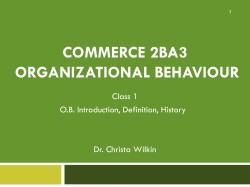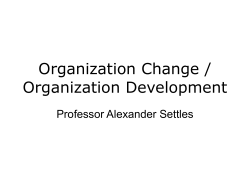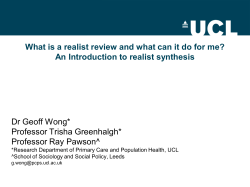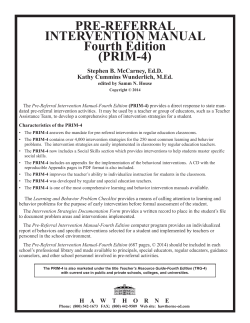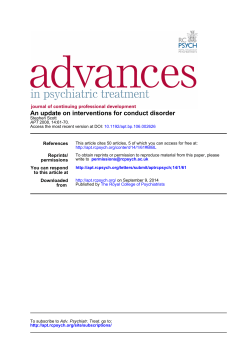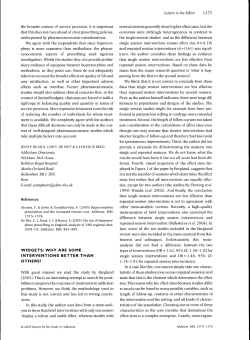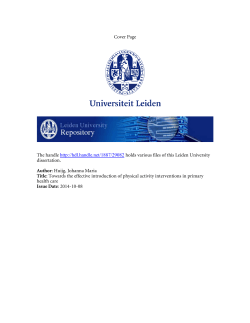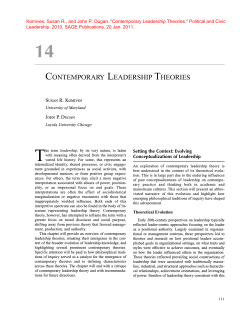
Why have behavioural approaches to Knowledge Transfer? Martin Eccles Professor of Clinical Effectiveness
Why have behavioural approaches to Knowledge Transfer? Martin Eccles Professor of Clinical Effectiveness What I’m going to talk about • Why think about behavioural approaches? • What we know about KT interventions and the problems with this • Theory in behavioural approaches • All patients should receive appropriate care Why think about behavioural approaches? • Human behaviour is a major determinant of health – Health related behaviours of patients – Health service providing behaviours of HCPs • Interventions can change behaviour – Patients • Behavioural versus pharma – KT • Behavioural • But there is much we don’t know • So … here’s a story to illustrate where we are in KT – With thanks to Kaveh Shojania & Jeremy Grimshaw A fairy story? • • • Replace “patients” with “KT problems” – the state of the science for promoting the translation of evidence from clinical research into practice. From the perspectives of clinical medicine and the research enterprise – Absurd to proceed directly from a patient’s poorly understood complaints to reaching for a bottle of pills simply because they are handy and resemble ones recommended anecdotally by a colleague. – The decision to administer these pills without any understanding of their active ingredients or their mode of action would be completely unsupportable Yet comparably unsupportable activities occur routinely in KT research What do we know? • Grimshaw JM, et al. Effectiveness and efficiency of guideline dissemination and implementation strategies. Health Technol Assess 2004. – 285 reports of 235 studies, 309 comparisons • Wensing, et al. Organizational interventions to implement improvements in patient care: a structured review of reviews. Implementation Science 2006. – “Planned re-arrangements of one or more aspects of the organization of patient care” – 36 reviews; 684 studies Results • Improvements in direction of effect in 86% of comparisons – Reminders most consistently observed to be effective – Educational outreach only led to modest effects – Dissemination of educational materials may lead to modest but potentially important effects (similar effects to more intensive interventions) – Multifaceted interventions not necessarily more effective than single interventions Results • • • • • • Revision of professional roles: 9 reviews • Can improve professional performance; preventive care Multidisciplinary teams: 5 reviews • Can improve patient outcomes; chronic diseases Integrated care services: 8 reviews • Can improve patient outcomes and save costs; chronic conditions Knowledge management: 6 reviews • Professional performance and patient outcomes can be improved; across conditions Quality management: 2 reviews • Effects remain uncertain Mixed interventions: 7 reviews • 6 showed positive effects So … what do we know? • Most things work some of the time – There are limitations • Methodological quality poor • Little economics (29%) or theory (27%) – Results likely to be confounded • Researchers didn’t randomly choose interventions • Differences in context etc. – Direct application of reviews problematic Foy R, et al. What do we know about how to do audit and feedback? Pitfalls in applying evidence from a systematic review. BMC Health Services Research 2005, 5:50. And … what do we need to know? • What is the efficiency of interventions? – How interventions work – Why interventions work – Can interventions be replicated • How generalisable are effects? Which means what, exactly? Which means what, exactly? • Generalisable frameworks – Empirical – Theoretical • Better studies (for another presentation) – Ask and answer smarter questions • Levels of engagement • Improved designs • Process evaluations Theories or models? • Classical theories/models of change can be informative and helpful for identifying the determinants of change • Provide organization for thinking, for observation, and for interpreting what is seen. • They provide a systematic structure and a rationale for activities – Interventions are more likely to be effective if they target causal determinants – these are theoretical constructs • Models reflect the philosophical stance, cognitive orientation, research tradition, and practice modalities of a particular group of scholars. • Researchers, policy makers, and change agents tend to be more interested in planned change theories/models that are specifically intended to be used to guide or cause change Using theories • Does theory apply to clinicians? – Are doctors human beings? • What do you want theory to do? • Describe or predict? • What level are you working at? Do theories of human behaviour (TPB) apply to clinicians? • Non-clinicians – Meta-analysis of 10 meta-analyses (Sheeran) • Intention accounted for 28% of the variance in behaviour – 185 independent studies (Armitage and Connor) • TPB (intention and perceived behavioural control) accounted for 27% of the variance in intention – 31% if behaviour measures were self-reports – 20% if behaviour measures were objective or observed – Meta-analysis of 47 experimental tests of the intention-behaviour relationship (Webb & Sheeran) • A “medium-to-large” change in intention leads to a “small-to-medium” change in behaviour Do theories of human behaviour (TPB) apply to clinicians? • Clinicians – Systematic review of 10 studies included a total of 1623 subjects (Eccles et al) • proportion of variance in behaviour explained by intention was of a similar magnitude to that found in non-health professionals • More consistently the case for studies in which intention-behaviour correspondence was good and behaviour was self-reported Choosing theories • Theories of “behaviour” or of “behaviour change”? – Focus on theories that: • Have been empirically tested • Explain behavior in terms of factors that are amenable to change • Include non volitional factors Michie et al. Making psychological theory useful for implementing evidence based practice: a consensus approach. QSHC 2005; 14: 26-33. Francis et al. TPB Manual. www.rebeqi.org Choosing theories: Levels • Four levels at which interventions to improve the quality of health care might operate: – Individual health professional – Health care groups or teams – Organisations providing health care (e.g., Acute hospitals) – The larger health care system or environment in which individual organizations are embedded Ferlie EB, Shortell SM. The Milbank Quarterly 2001 Choosing theories: Levels • Different theories will be relevant to interventions at different levels – Health Psychological theories may be more relevant to interventions directed at individuals and teams – Theories of organisational change may be more relevant to interventions directed at teams or hospitals • Little experience of “mix n match” across levels Conclusions • KT is a uniquely “behavioural arena” • Theory has the potential to lead to greater understanding • Theory potentially addresses generalisability • Which theory/theories to choose? – Theories of “what”? – “Behaviour” or “Behaviour change”? • Many unresolved methodological challenges in operationalising theory ? Implementation Science Co-Editors in Chief Martin Eccles, Brian Mittman Implementationscience.editors@ncl.ac.uk Scope All aspects of research relevant to the scientific study of methods to promote the uptake of research findings into routine healthcare in both clinical and policy contexts www.implementationscience.com References Armitage CJ, Conner M. Efficacy of the theory of planned behaviour: a meta-analytic review. British Journal of Social Psychology 2001;40:471-99. Eccles MP, Hrisos S, Francis J, Kaner E, Dickinson HO, Beyer F, Johnston M. Do self- reported intentions predict clinicians’ behaviour: a systematic review. Implementation Science, 2006; 1: 28. Ferlie EB, Shortell SM. Improving the quality of health care in the United Kingdom and the United States: a framework for change. The Milbank Quarterly 2001; 79(2):281-315. Foy R, Eccles MP et al. What do we know about how to do audit and feedback? Pitfalls in applying evidence from a systematic review. BMC Health Services Research 2005, 5:50. Grimshaw JM, Thomas RE, MacLennan G, Fraser C, Ramsay C, Vale L, Whitty P, Eccles M, Matowe L, Shirren L, Wensing M, Dijkstra R, Donaldson C. Effectiveness and efficiency of guideline dissemination and implementation strategies. Health Technol Assess 2004; 8(6). Michie S, M Johnston, C Abraham, R Lawton, D Parker, A Walker, on behalf of the ‘‘Psychological Theory’’ Group. Making psychological theory useful for implementing evidence based practice: a consensus approach. Qual Saf Health Care 2005;14:26–33. References Sheeran P. Intention-behavior relations: A conceptual and empirical review. In: Stroebe W, Hewstone M, editors. European Review of Social Psychology. John Wiley & Sons Ltd.; 2002. p. 1-36. Webb TL, Sheeran P. Does Changing Behavioural Intention Engender Behaviour Change? A Meta-analysis of the Experimental Evidence. Psychol Bull 2006;132(2):249-68. Wensing, Wollersheim, Grol. Organizational interventions to implement improvements in patient care: a structured review of reviews. Implementation Science 2006, 1:2.
© Copyright 2025

